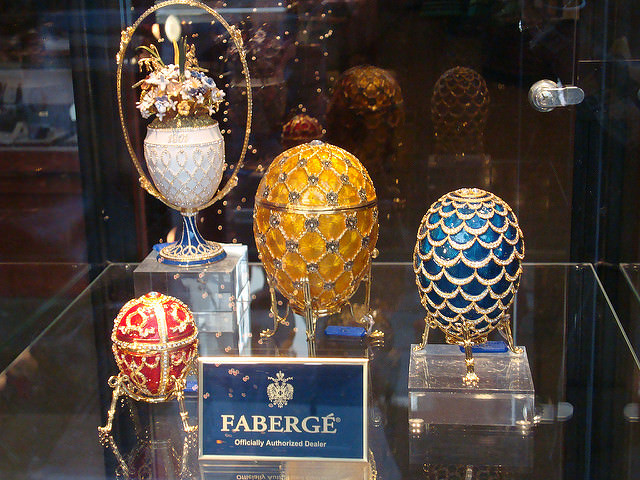The Unique Mystery behind the Russian Faberge Eggs
Peter Carl Faberge is the creator of the famed Russian Faberge eggs. The 69 jeweled Easter eggs made for Russia’s elite back in 1883 to 1917. Known as the Russian Imperial Court’s official jeweler. He made the “Faberge eggs” that the world knew as a symbol of luxury blatant for the world to see. However, the eggs are not only familiar because of its representation of luxury. They are also famous around the world for the missing 8 eggs of the original 69. For many years, people debate about the mystery behind the missing eggs. If you are as curious about what came of the eggs, this article tries to delve into the mystery.
The Birth of Russian Faberge Eggs
The birth of the Russian Faberge egg started shortly before the Easter of 1883. That was when Tsar Alexander III, the father of the last Tsar Nicholas II, had Faberge create a jeweled egg. The egg was an Easter gift for the tsar’s young wife, Maria Fiodorovna.
A Gift to Cheer the Young Maria
Born as Dagmar of Denmark, the young princess was sent away to marry the tsar a complete stranger. She became a foreign country’s new tsarina. That situation caused Maria to feel very homesick and depressed. The Tsar commissioned the very first Faberge egg to cheer her empress. An Exquisite Jewelled Easter Egg for the Imperial FamilyFaberge’s first jeweled Easter egg was nothing but exquisite. It’s made of platinum shell opened up so that it revealed a golden yolk. The yolk, in turn, displayed a tiny golden hen proud as it carried the Russian imperial crown. More than being superbly beautiful, it is also inspired by the Danish royal house’s existing collection.
A Maintained Imperial Tradition
As such, the imperial Easter egg also serves as a reminder of home for young Maria. The Tsar’s present did its job and cheered the young Tsarina so much so that it became a tradition. After the death of the Tsar, his son continued commissioning the Easter gifts, which contains splendid surprises inside.
The Missing Eggs
In the following years, a total of 52 imperial eggs. That Faberge oversaw became gifts to Maria as well as her daughter-in-law. Out of those, forty-four is accounted for while eight are lost. The number 43 and 44 of the eggs, the ‘Constellation Tsarevich’ and ‘Birch Karelia’. Were never completed because of the Russian Revolution and the Romanov family’s execution. A mystery that haunts art historians for many years. Out of the missing 8 eggs, people at least have an idea of how 5 of them look like. This is because of some existing photographs of the eggs with the Tsar’s family.
However, people never really knew the appearance of the last 3 missing eggs. The only proof of their existence is some records from the House of Faberge. However, a spectacular discovery happened when one of the missing eggs went on display at Wartski. The Third egg from 1887 was exhibited at Wartski in April 2014. The imperial Easter egg is a bejeweled, ridged yellow gold egg. Given to Empress Maria Fiodorovna by Emperor Alexander III for Easter 1887.
What Is So Special about Russian Style Faberge?
After the Russian Revolution and the Romanov family’s execution, there were no longer imperial eggs commissioned for the family. However, the House of Faberge remained in making luxury eggs for a hundred years. This is why the Russian style of Faberge eggs remain popular even today. These notorious eggs are frequently held in the Faberge Imperial Collection auctions by Catawiki. These auctions allow others to get their hands on their very own special Faberge style Easter treat.
If you want, you can even become a seller of these treasures. Putting your own collection of Russian Faberge eggs for sale. Starting your own auction is great as the Russian style Faberge never goes out of style. For a century, the name Faberge embodies exquisiteness, artistry, as well as tragedy. While its competitors remain as strong, Faberge is still the most famous and most mythical of all artist jewelers. Part of the attraction to the Faberge is the variety and volume of pieces that its name bears. It is not only Easter eggs, but many carefully crafted unique objects from pins and brooches to even opulent boxes. To Faberge, there is not a piece that is too frivolous or fanciful.
How Does Russian Style Faberge Differentiates Itself from All Others?
The thing that sets Russian style Faberge apart from its competitors. It is perhaps its intense passion for creating the most extraordinary objects possible. They enjoy one too many pieces of unique objects. That is extra whimsical and playful than any you have ever seen before. Far from the small family store that has seen its family name tarnished. The brand rose again and remained an international powerhouse for over a century. Today, Faberge’s workshops employ more than hundreds of stone carvers. Enamellists, and goldsmiths.
These artisans now use modern conveniences as they create the best and most coveted pieces of jewelry in the world. One of the many uniqueness of the Faberge brand is: that they allow their workmasters to have their own firms. A part of the Faberge umbrella, they even have their initials signed on their creations. With this, experts can identify the individual pieces under Faberge as they have their own distinctive styles.
Another thing that differentiates the brand from all. Is the fact their craftsmen are more than happy to use inexpensive stones. They often use inexpensive ones if it suits their creations. As such, even though the famous imperial Easter eggs of the Russian Romanov family. Were full of diamonds and costly metals as well as enamels. Those were not the only things Faberge offers. They even created a dormouse made of chalcedony that has eyes made of sapphire and whiskers made of platinum. The materials used were inexpensive compared to that of the imperial eggs. But Queen Alexandra of Britain bought it in 1912 for 33 pounds. After the Third egg’s discovery. Anyone who discovers any of the remaining eggs will surely earn a fortune and a place in the Faberge legacy.
My name is Sasha, I’m a father of two. Work in the tech industry. For fun I am running a small business in addition to that, sometimes I write and edit content regarding topics that interest me like: entertainment, tech, finance and art.


Leave a Reply
You must be logged in to post a comment.